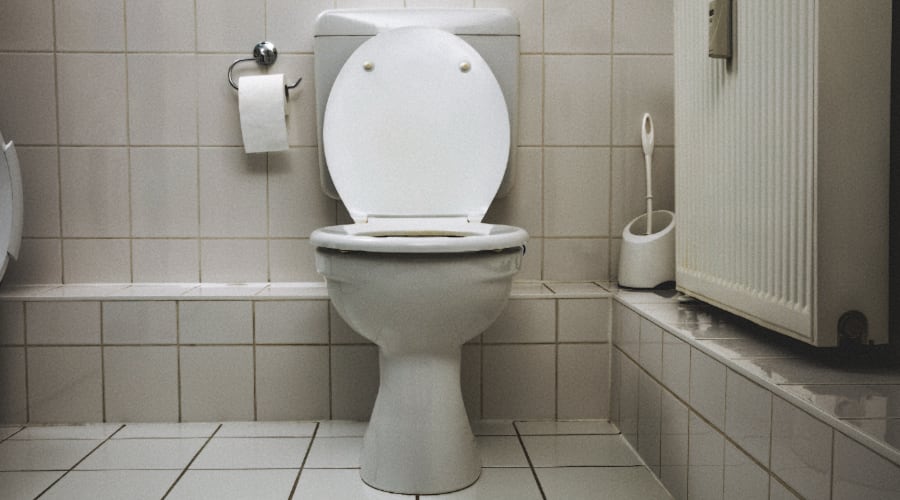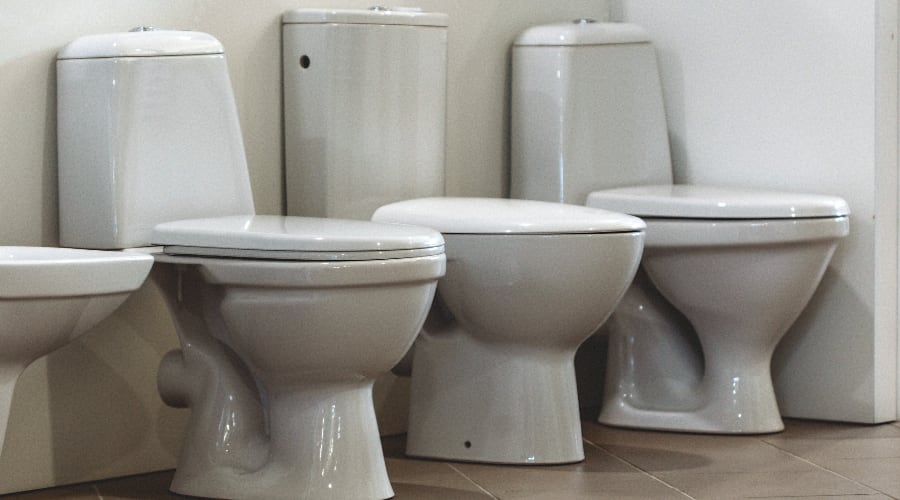If you’re purchasing a new toilet or doing a bathroom remodel, you may wonder how much a toilet actually weighs. After all, toilets come with many options, and finding the right one is important for your personal comfort level.
You may also prefer a certain size toilet and need to ensure that it meets the requirements for your bathroom remodel specs.
So, how much does a toilet weigh?
We’ve looked into toilet weights and other details surrounding them to provide this answer to this question for you.
How Heavy Is a Toilet?
Your average toilet will weigh anywhere from 60 to 130 pounds. Keep in mind that this is the weight for the average floor-mounted toilet, as wall-mounted toilets tend to be a bit lighter.
The weight of the toilet also depends on whether it’s a one- or two-piece, as they generally have different average weights.
It’s also important to note that these are the average dry weights of a standard toilet. They aren’t inclusive of the weight once water and a lid are present.
After most toilets are installed, an additional 20 pounds will be added to the weight due to both of these, as well as a seat.
Weight of 2-Piece Toilets
On average, the typical two-piece toilet can weigh anywhere from about 60 to 110 pounds.
However, if you go online, you’ll find that most toilets will weigh about 60 lbs, give or take the make and model.
Two-piece toilets are more common than one-piece toilets, and they’re surprisingly light as well.
Average Toilet Tank Weight
The average weight of a toilet tank alone may be less than you think — typically, they will weigh anywhere from 25 to 45lbs.
This is because the tank usually accounts for just a third of the toilet’s total weight. Though, if the tank has any additional fixtures or is custom-made, an additional 5 to 10 lbs can be added to its final weight.
Average Toilet Bowl Weight
The toilet bowl is usually a bit heavier than the tank at about twice its weight. Your average toilet bowl weighs around 50 to 70 lbs.
Again this can vary depending on the make and model of the toilet.
Weight of 1-Piece Toilets
One-piece toilets typically weigh significantly more than two-piece toilets and average about 85 to 90 lbs. Note that this will vary depending on the make, model, and material of the toilet.
Weight of a Wall-Hung Toilet
Wall-hung toilets will usually weigh much less because of their anchoring requirements.
On average, they’ll have a weight of about 50 to 70 pounds.

Why Are 1-Piece Toilets Heavier Than 2-Piece Toilets?
Good question.
One-piece toilets are typically heavier than two-piece toilets because the entire unit is already put together.
Two-piece toilets are designed with portability in mind, meaning that the toilet will need to be taken apart before it can be moved from one place to another.
This makes them easier to install and remove, and also makes them more convenient and cheaper to ship.
Can One Person Lift a Toilet?
It really depends on the person.
If you’re confident in your ability to lift a hundred-or-so-pound object, you’ll probably be able to lift your toilet with some effort.
However, keep in mind that toilets are an irregular shape, and so are notoriously difficult and awkward to move. With this in mind, it’s always a good idea to have a bit of assistance if you plan to replace or install a new toilet in your home or apartment.
Do Toilets Have Weight Limits?
Yes, they do.
Because the weight of a floor-mounted toilet will need to be supported by the building’s structure, there is a cap of about 1000 lbs in most countries. However, a wall-mounted toilet typically has a weight cap of about 500 lbs.
These weight caps are important — they ensure that the toilets are sturdy enough to support a person’s body weight while also being light enough to not cause issues with the supporting structures of a home or building.
Floor-Mounted Toilets
Floor-mounted toilets are the most commonly used type of toilet in homes and apartment buildings.
There aren’t governmental agencies that regulate the weight requirements that the toilet must hold, but you’ll find that most are designed to be able to support 1000 lbs of weight.
Wall-Mounted Toilets
Wall-mounted toilets are less common in apartments and homes, and are typically lighter than floor-mounted toilets.
These toilets can weigh anywhere from 50 to 80 lbs on average.
According to the U.S. ASME National Consensus Standards, a wall-hung toilet must have a minimum weight limit of 500 lbs.
Due to their anchoring, wall mounted toilet seats don’t have the holding capacity of floor mounted toilet seats — which explains their lighter build.

What Contributes to a Toilet’s Weight?
The three factors that contribute most to a toilet’s weight are its size, design, brand, and the material that it’s composed of.
Toilet Size and Design
Different strokes for different folks. If you’re currently shopping around for a new toilet and are concerned about the weight, you’ll be happy to know that there are several different toilet designs, styles, and sizes to choose from.
The size and design of your toilet can play a significant part in how much the toilet weighs.
Some people prefer smaller, more compact toilets because they’re easier to access, work better in small bathrooms, and are budget-friendly. These, of course, weigh less.
In contrast, others prefer larger or more extravagant toilets made from expensive materials or by luxury brands, which will weigh more.
Toilet Brand
If you prefer something fancier, you may find that your toilet will weigh a bit more than the average.
Luxury toilet brands such as Toto, Kohler, MiniLoo, and Laufen’s Ilbagnoalessi typically add additional materials and decorative items to their toilets, making them heavier than the average wall or floor-mounted option.
These toilets may also come with additional features for convenience and comfort, and all this can add 5 to 15 lbs to the total weight.
Toilet Material
The weight of a toilet mostly depends on the material used to build it.
More often than not, porcelain is the most commonly used material when it comes to toilets — the bowl and tank in particular. Since porcelain is a clay product, it’s fairly heavy and makes for a very stable base to support body weight.
The type of clay used to make the porcelain can also play a role in determining the final weight of the toilet.
And if a toilet has seating made of wood or plastic, this can affect the weight, but only slightly.
Conclusion
Knowing how much a toilet weighs is important if you plan to replace a broken or outdated one, or if you are remodeling your entire bathroom.
Keep in mind that, for the most part, the weight of the toilet will depend on the toilet’s material, design, and size, though the brand might also play a role.
Also, if you are planning to replace your toilet on your own, it’s best to have someone there to help you remove the old one and install the new one. These appliances can be fairly heavy to lift, solo.
